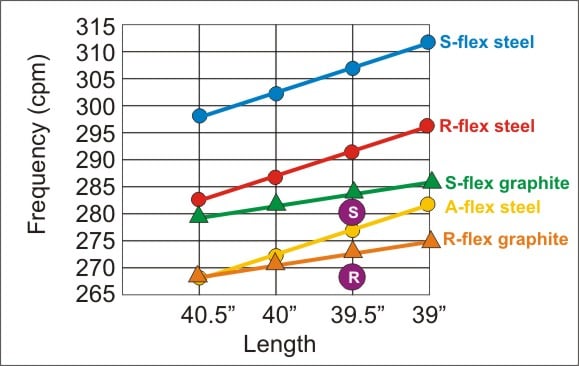What Specifications Make a Good Shaft for a Hybrid Clubhead?
Jeff Summitt Discusses The Ins and Outs of Choosing The Best Hybrid Shaft For Your Game
There is no doubt about it: the modern hybrid golf club has made golf a little easier by replacing harder-to-hit clubs. Even the best players in the world often carry at least one hybrid in their bag. The hybrid is just so easy to hit that picking the wrong shaft does not penalize a player as much as doing so with an iron. Even so, there are still some guidelines to follow.
 What is the hybrid golf shaft?
What is the hybrid golf shaft?
Many of the OEM shaft manufacturers have already done much of the heavy-lifting by creating hybrid-specific shafts. We can look at these shafts to get an idea of which factors are optimal. The majority of hybrid-specific shafts all have a few common denominators. First they possess low torque measurements (more resistant to twisting), due to the fact that the size and shape of a hybrid is quite different from that of an iron head. But one other specification that is unexpected is how flexible hybrid shafts are when compared to standard iron shafts.
In the diagram is a plot of average club frequencies of the various types of golf shafts. Frequency is a measure of the shaft’s stiffness by clamping the butt end in a special device; pluck the shaft to set it in motion and the device measures the number of oscillations. The higher the number the stiffer the shaft is said to be. Note that there are no industry standards for flex, but this chart provides a good starting point to see the relative stiffness from on shaft to the next. The circles colored in the purple represent average frequencies of the hybrid-specific graphite shafts. There haven’t been that many steel hybrids shafts, but the few are in the proximity of 275 cpm for R-flex and 285 cpm for S-flex at 39.5”.
Can you use an iron shaft for a hybrid club?
In experimenting with a number of shaft and head combinations, I stumbled across a few shafts designed for iron heads that seemed to work well, but only with certain types of heads. One was the Apollo Shadow Lite A-flex, which is designed for senior golfers with a slow and rhythmic swing. I normally play S-flex (as in stiff). Using this shaft in an iron I am all but inconsistent not knowing if the ball is going left or right. Not surprising since I am not the target audience for this model. But put that same shaft in a hybrid that weighs the exact same as an iron and length too and I hit is consistently straight. It wasn’t just with one particular hybrid, but a number of them that varied in their size, shape and amount of face progression. Why?
| Average Frequency at 39.5” | cpm |
| R-flex Steel Iron | 292 |
| R-flex Graphite Iron | 273 |
| R-flex Graphite Hybrid | 268 |
| R-flex Steel Hybrid | 275 |
| S-flex Steel Iron | 307 |
| S-flex Graphite Iron | 285 |
| S-flex Graphite Hybrid | 281 |
| S-flex Steel Hybrid | 285 |
| A-flex Steel Iron | 277 |
 Steel is inherently low torque. Couple this with the fact the physical dimensions of a hybrid is much different from an iron which results into a higher moment of inertia (especially if the hybrid weighs the same as an iron). While I did hit hybrids with much stiffer S-flex steel shafts well, I hit the more flexible shafts even better. Not only did the softer shaft feel appeal to me, but the ball flight was much higher than an iron, distance may have been slightly greater AND with no loss of accuracy. I have turned a few other stronger or faster swinging customers over to using the Shadow A-flex steel shaft in their hybrids and they have reported similar success (plus were happy that it was only a $5 experiment)!!!
Steel is inherently low torque. Couple this with the fact the physical dimensions of a hybrid is much different from an iron which results into a higher moment of inertia (especially if the hybrid weighs the same as an iron). While I did hit hybrids with much stiffer S-flex steel shafts well, I hit the more flexible shafts even better. Not only did the softer shaft feel appeal to me, but the ball flight was much higher than an iron, distance may have been slightly greater AND with no loss of accuracy. I have turned a few other stronger or faster swinging customers over to using the Shadow A-flex steel shaft in their hybrids and they have reported similar success (plus were happy that it was only a $5 experiment)!!!
Another shaft that worked well for me in a hybrid, but not necessarily in an iron was the Apollo Hump R-flex. This produced a little flatter trajectory than the Shadow A-flex. Combing through at all the free published data about golf shafts, one other steel shaft that has the low frequency (stiffness) / low torque combination is the Apollo Acculite 75 which should make an excellent hybrid shaft as well. In graphite, our proprietary SK Fiber Tour Trac 75 iron shafts also have that combination of low frequency and low torque and have made good hybrid shafts too, especially if using the softer sub-flex trimming option.
Conclusion
When choosing a shaft for a hybrid, look for shafts that are low in torque and low in frequency (more flexible). It can be one of the special hybrid-specific shafts, or you can also use a regular iron shaft (for hybrids with standard iron hosel bores). But in doing the latter, don’t be afraid to drop a flex or two when using steel.
